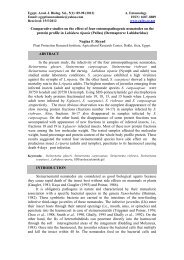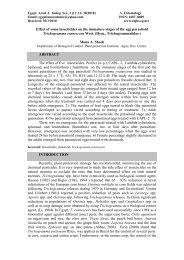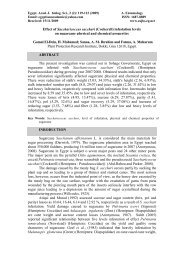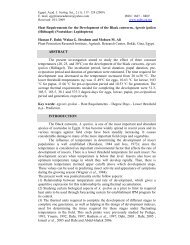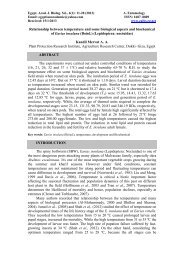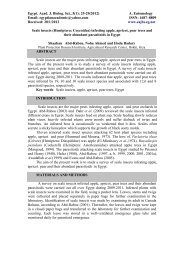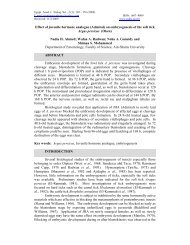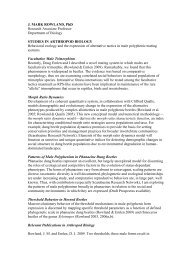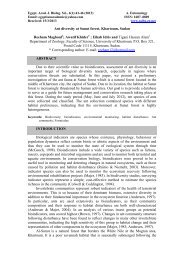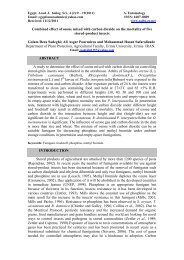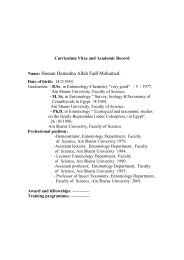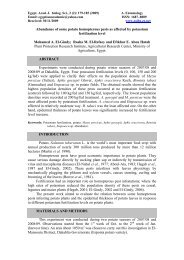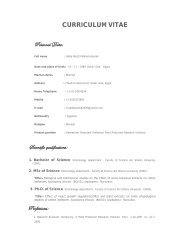Survey of eriophyid mites on some fruit trees, with re-descriptions of ...
Survey of eriophyid mites on some fruit trees, with re-descriptions of ...
Survey of eriophyid mites on some fruit trees, with re-descriptions of ...
Create successful ePaper yourself
Turn your PDF publications into a flip-book with our unique Google optimized e-Paper software.
Egypt. Acad. J. biolog. Sci., 5 (2):205 -216 (2012) A. Entomology<br />
Email: egyptianacademic@yahoo.com ISSN: 1687–8809<br />
Received: 5/10/2012<br />
www.eajbs.eg.net<br />
<str<strong>on</strong>g>Survey</str<strong>on</strong>g> <str<strong>on</strong>g>of</str<strong>on</strong>g> <str<strong>on</strong>g>eriophyid</str<strong>on</strong>g> <str<strong>on</strong>g>mites</str<strong>on</strong>g> <strong>on</strong> <strong>some</strong> <strong>fruit</strong> <strong>t<strong>re</strong>es</strong>, <strong>with</strong> <strong>re</strong>-descripti<strong>on</strong>s <str<strong>on</strong>g>of</str<strong>on</strong>g> two newly<br />
<strong>re</strong>corded species and a checklist <str<strong>on</strong>g>of</str<strong>on</strong>g> <str<strong>on</strong>g>eriophyid</str<strong>on</strong>g> <str<strong>on</strong>g>mites</str<strong>on</strong>g> in Egypt (Acari:<br />
Eriophyoidea)<br />
Ashraf S. H. El-Halawany<br />
E-mail dr_ashraf_said@yahoo.com<br />
Plant Protecti<strong>on</strong> Research Institute (PPRI), Agricultural Research Center (ARC),<br />
Dokki, Giza, 12618 Egypt<br />
ABSTRACT<br />
In a field survey, 16 eriophyoid mite species we<strong>re</strong> collected from eight species<br />
<str<strong>on</strong>g>of</str<strong>on</strong>g> <strong>fruit</strong> <strong>t<strong>re</strong>es</strong>, am<strong>on</strong>g which two species we<strong>re</strong> found to be new <strong>re</strong>cord to Egypt. They<br />
we<strong>re</strong> Tegolophus guavae (Boczek, 1960) <strong>on</strong> Psidium guajava L. (Myrtaceae) which<br />
causes rust <strong>on</strong> leaves, and Aceria ziziphi Mohanasundaram, 1990, vagrant <strong>with</strong>out<br />
damage <strong>on</strong> Ziziphus spina-christi Willd (Rhamnaceae). These species we<strong>re</strong><br />
<strong>re</strong>described and illustrated from local material. A total <str<strong>on</strong>g>of</str<strong>on</strong>g> 65 eriophyoid mite species<br />
in superfamily Eriophyoidea has been <strong>re</strong>corded in Egypt due to literatu<strong>re</strong>. These<br />
species bel<strong>on</strong>g to th<strong>re</strong>e families, seven sub families, seven tribes and 27 genera. A list<br />
<str<strong>on</strong>g>of</str<strong>on</strong>g> these species has been c<strong>on</strong>structed and p<strong>re</strong>sented he<strong>re</strong>in.<br />
Key words: <str<strong>on</strong>g>Survey</str<strong>on</strong>g>, Eriophyidae, Phytoptidae, Diptilomiopidae, Checklist, Egypt.<br />
INTRODUCTION<br />
Eriophyid <str<strong>on</strong>g>mites</str<strong>on</strong>g> play an important role in Egyptian agro-ecosystem. The last<br />
collective work <strong>on</strong> <str<strong>on</strong>g>eriophyid</str<strong>on</strong>g> <str<strong>on</strong>g>mites</str<strong>on</strong>g>' tax<strong>on</strong>omy was occur<strong>re</strong>d by Zaher (1984). About<br />
30 papers <strong>on</strong> tax<strong>on</strong>omy <str<strong>on</strong>g>of</str<strong>on</strong>g> <str<strong>on</strong>g>eriophyid</str<strong>on</strong>g> <str<strong>on</strong>g>mites</str<strong>on</strong>g> in Egypt, from 1919 up to date, have been<br />
published by (Dçbski, 1919; Hassan, 1934; Sayed, 1946a, 1946b; Attiah, 1955, 1967<br />
& 1970; Osman & Zohdy, 1976; Soliman & Abou-Awad, 1977 & 1978; Rasmy &<br />
Abou-Awad, 1978; Abou-Awad, 1979a, 1979b, 1981 & 1984; Abou-Awad & Nasr,<br />
1983a, 1983b & 1986; Zaher, 1984; Zaher & Abou-Awad, 1978, 1979, 1980a &<br />
1980b; Zaher et al., 1978; Osman & Abou-Taka, 1989; Abou-Awad & El-Sawi, 1993;<br />
Abou-Awad & El-Borolossy, 1995; El-Halawany et al., 2001 and Abou Awad et al.,<br />
2011. About 63 species we<strong>re</strong> <strong>re</strong>corded. The p<strong>re</strong>sented work aimed to survey<br />
<str<strong>on</strong>g>eriophyid</str<strong>on</strong>g> <str<strong>on</strong>g>mites</str<strong>on</strong>g> <strong>on</strong> eight <strong>fruit</strong> <strong>t<strong>re</strong>es</strong> and to collect the informati<strong>on</strong> in tables, <strong>re</strong>lated to<br />
their host plants. In additi<strong>on</strong>, <strong>re</strong>descripti<strong>on</strong>s <str<strong>on</strong>g>of</str<strong>on</strong>g> two species <strong>re</strong>corded for the first time<br />
in Egypt a<strong>re</strong> p<strong>re</strong>sented. A checklist to the Egyptian eriophyoid <str<strong>on</strong>g>mites</str<strong>on</strong>g> a<strong>re</strong> provided too.<br />
MATERIAL AND METHODS<br />
A survey was carried out in Qalubia Governorate included eight species <str<strong>on</strong>g>of</str<strong>on</strong>g> <strong>fruit</strong><br />
<strong>t<strong>re</strong>es</strong>, namely Guava (Psidium guajava L.), Christ thorn (Ziziphus spina-christi<br />
Willd), Date palm (Phoenix dactylifera L.), Apple (Malus domestica Borkh.),<br />
Sycamo<strong>re</strong> fig (Ficus sycomorus L.), Olive (Olea europaea L.), Fig (Ficus carica L.)<br />
and Mulberry (Morus alba L.). Sampling was carried out ir<strong>re</strong>gularly from October<br />
2011 to September 2012 including plant foliages, branches, flowers and buds.<br />
Samples we<strong>re</strong> individually bagged in tightly-closed plastic bags and transported the<br />
same day to the Fruit Acarology Department, Plant Protecti<strong>on</strong> Research Institute
206<br />
Ashraf S. H. El-Halawany<br />
(PPRI), Agricultural Research Center (ARC) for mite extracti<strong>on</strong>. A microscope <strong>with</strong><br />
an attached drawing tube was used for examinati<strong>on</strong> and drawing the mite species<br />
Tegolophus guavae and Aceria ziziphi which we<strong>re</strong> <strong>re</strong>corded for the first time in Egypt.<br />
The oil lens was used to examine the fetherclaw, microtubercles and male and female<br />
genitalia. The measu<strong>re</strong>ments a<strong>re</strong> given in micrometer (µm) and GPS technique is used<br />
to identify located samples. The terminology and morphological characteristics used<br />
in this study a<strong>re</strong> based <strong>on</strong> Lindquist (1996) and Amrine et al. (2003). All specimens<br />
we<strong>re</strong> deposited in the Fruit Acarology Department, Plant Protecti<strong>on</strong> Research Institute<br />
collecti<strong>on</strong>, Agricultural Research Center.<br />
Mo<strong>re</strong> than 28 original scientific papers published <strong>on</strong> <str<strong>on</strong>g>eriophyid</str<strong>on</strong>g> <str<strong>on</strong>g>mites</str<strong>on</strong>g> from<br />
Egypt we<strong>re</strong> collected from diffe<strong>re</strong>nt libraries in Egyptian Universities and Research<br />
Centers. On the other side, the <strong>re</strong>fe<strong>re</strong>nces collected from Egypt we<strong>re</strong> c<strong>on</strong>firmed by the<br />
Catalogue <str<strong>on</strong>g>of</str<strong>on</strong>g> the Eriophyoidea <str<strong>on</strong>g>of</str<strong>on</strong>g> the world (Versi<strong>on</strong> computer <str<strong>on</strong>g>of</str<strong>on</strong>g> Filemaker Pro 4.0.<br />
(De Lillo & Amrine, 2009) pers<strong>on</strong>al communicati<strong>on</strong>). All <str<strong>on</strong>g>eriophyid</str<strong>on</strong>g> species <strong>re</strong>corded<br />
in Egypt and their host plants a<strong>re</strong> now up to date.<br />
RESULTS AND DISCUSSION<br />
<str<strong>on</strong>g>Survey</str<strong>on</strong>g> <str<strong>on</strong>g>of</str<strong>on</strong>g> <str<strong>on</strong>g>eriophyid</str<strong>on</strong>g> <str<strong>on</strong>g>mites</str<strong>on</strong>g> <strong>on</strong> eight <strong>fruit</strong> crops<br />
Sixteen <str<strong>on</strong>g>eriophyid</str<strong>on</strong>g> mite species we<strong>re</strong> collected from eight <strong>fruit</strong> <strong>t<strong>re</strong>es</strong> species at<br />
Qalubia Governorate. The host plant and GPS a<strong>re</strong> provided (Table 1).<br />
Table 1: Results <str<strong>on</strong>g>of</str<strong>on</strong>g> survey <str<strong>on</strong>g>of</str<strong>on</strong>g> eriophyoid <str<strong>on</strong>g>mites</str<strong>on</strong>g> from Qalubia Governorate.<br />
Classificati<strong>on</strong> Scientific name Host plant GPS<br />
Family: Diptilomiopidae Diptilomiopus ficus Attiah, 1967 Ficus carica L.,<br />
30º20'18.67"N<br />
Sub family: Diptilomiopinae<br />
(Moraceae)<br />
31º15'15.12"E<br />
Sub family: Rhyncaphytoptinae Rhyncaphytoptus ficifoliae Keifer, 1939a Ficus carica L.,<br />
30º20'18.67"N<br />
(Moraceae)<br />
31º15'15.12"E<br />
Family: Eriophyidae<br />
Aceria ficus (Cotté, 1920) Ficus carica L.,<br />
30º20'18.67"N<br />
Sub family: Eriophyinae<br />
Tribe: Aceriini<br />
(Moraceae)<br />
31º15'15.12"E<br />
Aceria mori (Keifer, 1939a) Morus alba L.,<br />
30º16'10.30"N<br />
(Moraceae)<br />
31º14'37.88" E<br />
Aceria oleae (Nalepa, 1900) Olea europaea L.,<br />
30º1'8.21"N<br />
(Oleaceae)<br />
31º12'28.04"E<br />
Aceria olivi (Zaher & Abou-Awad, 1979) Olea europaea L.,<br />
30º1'8.21"N<br />
(Oleaceae)<br />
31º12'28.04"E<br />
Aceria sycamori (Soliman & Abou-Awad, Ficus sycomorus L.,<br />
30º18'37.17"N<br />
1977)<br />
(Moraceae)<br />
31º15'49.27"E<br />
Aceria ziziphi Mohanasundaram, 1990; Ziziphus spina-christi 30<br />
New <strong>re</strong>cord<br />
Willd (Rhamnaceae)<br />
◦ 15'50.46"N<br />
31 ◦ 14'51.85"E<br />
Tribe: Eriophyini Eriophyes pyri (Pagenstecher, 1857) Malus domestica Borkh., 30º10'59.89"N<br />
(Rosaceae)<br />
31º7'39.52"E<br />
Sub family: Phyllocoptinae Tegolophus hassani (Keifer, 1959) Olea europaea L.,<br />
30º1'8.21"N<br />
Tribe: Anthocoptini<br />
(Oleaceae)<br />
31º12'28.04"E<br />
Tegolophus guavae (Boczek, 1960); New Psidium guajava L.<br />
30<br />
<strong>re</strong>cord<br />
(Myrtaceae)<br />
◦ 14'51.85"N<br />
31 ◦ 17'07.89"E<br />
Tegolophus niloticus Abou-Awad, 1984 Ficus sycomorus L.,<br />
30º18'37.17"N<br />
(Moraceae)<br />
31º15'49.27"E<br />
Tribe: Phyllocoptini Calepitrimerus baileyi Keifer (1938b) Malus domestica Borkh., 30º10'59.89"N<br />
(Rosaceae)<br />
31º7'39.52"E<br />
Epitrimerus pyri (Nalepa, 1891) Malus domestica Borkh., 30º10'59.89"N<br />
(Rosaceae)<br />
31º7'39.52"E<br />
Tribe: Teg<strong>on</strong>otini Oxycenus maxwelli (Keifer, 1939a) Olea europaea L.,<br />
30º1'8.21"N<br />
(Oleaceae)<br />
31º12'28.04"E<br />
Subfamily: Sierraphytoptinae Mackiella phoenicis Keifer, 1939a Phoenix dactylifera L., 30º17'20.02"N<br />
Tribe: Mackiellini<br />
(A<strong>re</strong>caceae )<br />
31º14'51.85"E
<str<strong>on</strong>g>Survey</str<strong>on</strong>g> <str<strong>on</strong>g>of</str<strong>on</strong>g> <str<strong>on</strong>g>eriophyid</str<strong>on</strong>g> <str<strong>on</strong>g>mites</str<strong>on</strong>g> <strong>on</strong> <strong>some</strong> <strong>fruit</strong> <strong>t<strong>re</strong>es</strong>, <strong>with</strong> <strong>re</strong>-descripti<strong>on</strong>s <str<strong>on</strong>g>of</str<strong>on</strong>g> two newly <strong>re</strong>corded 207<br />
Re-descripti<strong>on</strong>s <str<strong>on</strong>g>of</str<strong>on</strong>g> two newly <strong>re</strong>corded species<br />
Two species Tegolophus guavae (Boczek) and Aceria ziziphi Mohanasundram we<strong>re</strong><br />
<strong>re</strong>corded <strong>on</strong> Psidium guajava and Ziziphus spina-christi for the first time in Egypt.<br />
The following a<strong>re</strong> <strong>re</strong>-descripti<strong>on</strong>s <str<strong>on</strong>g>of</str<strong>on</strong>g> them.<br />
Tegolophus guavae (Boczek, 1960) (Fig. 1)<br />
Teg<strong>on</strong>otus guavae Boczek, 1960: 11.<br />
Tegolophus guavae (Boczek, 1960) Amrine & Stasny, 1996: 300.<br />
Material examined: Qalubia; 6.VIII.2012, (Ashraf El-Halawany), Psidium guajava L.,<br />
(10 ♀♀, 6 ♂♂) (30 ◦ 14'57.94"N; 31 ◦ 17'07.89"E).<br />
FEMALE: Body fusiform, light yellowish in colour, 204 (180-225) l<strong>on</strong>g, 72 (60-80)<br />
wide; Gnathosoma16 (15–17), projecting obliquely downwards, pedipalp coxal setae<br />
(ep) 2 (2-3), dorsal pedipalp genual setae (d) 4 (4-5), chelicerae 14.5 (13.5-15.5), oral<br />
stylets 14 (12-16). Prodorsal shield rounded shape in <strong>re</strong>ar <strong>with</strong> 39.5 (35-46) l<strong>on</strong>g, 55.5<br />
(46-70) wide; median line split near center <str<strong>on</strong>g>of</str<strong>on</strong>g> shield into two lines which do not <strong>re</strong>ach<br />
anterior margin, surface <str<strong>on</strong>g>of</str<strong>on</strong>g> shield punctuated. Fr<strong>on</strong>tal lobe broad 5.5 (4.5-7) l<strong>on</strong>g.<br />
Dorsal tubercles ahead <str<strong>on</strong>g>of</str<strong>on</strong>g> near <strong>re</strong>ar margin, 33 (32-40) apart, scapular setae (sc) 12.5<br />
(10-16), tubercles (sc) 2.5 (2.5-3) near <strong>re</strong>ar margin di<strong>re</strong>cted (sc) divergently<br />
backwards. Coxal a<strong>re</strong>a <strong>with</strong> short lines; included 10 (10-11) annuli, coxal setae<br />
p<strong>re</strong>sented, coxae punctuaed, anterolateral setae <strong>on</strong> coxisternum І(1b) 9.5 (8-12) apart,<br />
12 (11-14) l<strong>on</strong>g, proximal setae <strong>on</strong> coxisternum І(1a) 14 (10-15) apart, 6 (4.5-7) l<strong>on</strong>g,<br />
proximal setae <strong>on</strong> coxisternum ІІ(2a) 24 (21-30) apart, 28 μ (22-35) l<strong>on</strong>g. Prosternal<br />
apodeme p<strong>re</strong>sent. Legs <strong>with</strong> usual series <str<strong>on</strong>g>of</str<strong>on</strong>g> setae. Legs І 38 (36-40), femur 9 (7–13),<br />
basiventral femoral setae (bv) 9 (8–13); genu 6 (4.5–7), antaxial genual setae (l'') 25<br />
(19–26); tibia 8 (7.5-9), paraxial tibial setae (l') 5 (4.5–6), setae located at center;<br />
tarsus 5.5 (5–7.5); tarsal empodia simple 6(5-7), 4-rayed, tarsal solenidi<strong>on</strong> 5.5 (5-7.5)<br />
l<strong>on</strong>g knobbed, dorsal setae (ft") 13 (10-20) l<strong>on</strong>g, lateral setae (ft') 16.5 (12-25) l<strong>on</strong>g.<br />
Legs ІІ 36 (30–40) l<strong>on</strong>g, femur 9 (8–10) l<strong>on</strong>g, basiventral femoral setae (bv) 13 (12–<br />
16) l<strong>on</strong>g; genu 6 (5–7), antaxial genual setae (l'') 4.5 (4–6); tibia 6.5 (6-7.5); tarsus 7.5<br />
(5-9) l<strong>on</strong>g, solenidia 8.5 (7-10) l<strong>on</strong>g, knobbed, empodia 7 (5.5-8) l<strong>on</strong>g, (ft") 5 (4-6)<br />
l<strong>on</strong>g, (ft') 23 (20-28) l<strong>on</strong>g. Opisthosoma the dorsal <strong>with</strong> 27 (26-28) annuli, smooth,<br />
ventrally <strong>with</strong> 64 (61–71) annual, <strong>with</strong> round microtubercles. Setae c2 17 (13–21)<br />
l<strong>on</strong>g, <strong>on</strong> ventral annulus 9 (8–10) posterior to coxae; setae d 50 (45-60) l<strong>on</strong>g, <strong>on</strong><br />
ventral annulus 25 (22–28), 38 (30-40) apart; setae e 11 (9-13) l<strong>on</strong>g, <strong>on</strong> ventral<br />
annulus 41 (36-44), 17.5 (14-21) apart; setae f 25 (22-25) l<strong>on</strong>g, <strong>on</strong> 6th ventral annulus<br />
from <strong>re</strong>ar. Setae h1 absent. Caudal setae (h2) 63 (54-70) l<strong>on</strong>g; Female genitalia 15.5<br />
(14–20) l<strong>on</strong>g, 22 (20–27) wide, coverflap <strong>with</strong> 12 (10-12) l<strong>on</strong>gitudinal ridges,<br />
proximal setae <strong>on</strong> coxisternum ІІІ (3a) 8 (7-10) l<strong>on</strong>g, 15(13-20) apart.<br />
MALE: Body fusiform, light yellowish in colour 179 (165-200) l<strong>on</strong>g, 58 (50-68)<br />
wide; light yellow. Gnathosoma length 15 (15–17), projecting obliquely downwards,<br />
pedipalp coxal setae (ep) 2 (2-3), dorsal pedipalp genual setae (d) 4 (4-5), chelicerae<br />
13 (13-14), oral stylets 12 (12-14). Prodorsal shield 41 (38–45), l<strong>on</strong>g, 52 (43–65)<br />
wide; fr<strong>on</strong>tal lobe broad 6.5 (5-8) l<strong>on</strong>g, scapular setae (sc) 12.5 (10-16), tubercles (sc)<br />
2.5 (2.5-3) near <strong>re</strong>ar margin di<strong>re</strong>cted (sc) divergently backwards. Coxal a<strong>re</strong>a <strong>with</strong><br />
short lines; <strong>with</strong> 13 (12-14) annuli, and usual segments and setae p<strong>re</strong>sent, coxae <strong>with</strong><br />
ir<strong>re</strong>gular dashes. Legs <strong>with</strong> usual series <str<strong>on</strong>g>of</str<strong>on</strong>g> setae. Legs І 37 (30-40), femur 8 (7–11),<br />
setae (bv) 9 (8–10); genu 5 (5–6), setae (l'') 22 (19–23); tibia 8 (8-10), setae (l') 5 (4–<br />
6); tarsus 6 (6–8); tarsal empodia 6 (5-7), 4-rayed, tarsal solenidi<strong>on</strong> 6 (5-7) l<strong>on</strong>g<br />
knobbed, dorsal setae (ft") 14(10-17) l<strong>on</strong>g, lateral setae (ft') 14 (12-20) l<strong>on</strong>g. Legs ІІ
208<br />
Ashraf S. H. El-Halawany<br />
33 (31–40) l<strong>on</strong>g, femur 8 (8–10) l<strong>on</strong>g, setae (bv) 13 (12– 15) l<strong>on</strong>g; genu 5 (5–6),<br />
setae (l'') 4.5 (4–6); tibia 6.5 (6-7.5); tarsus 7 (5-8) l<strong>on</strong>g, solenidia 7 (7-9) l<strong>on</strong>g,<br />
knobbed, empodia 6.5 (6-7.5) l<strong>on</strong>g, (ft") 5 (4-6) l<strong>on</strong>g, (ft') 20 (18-23) l<strong>on</strong>g.<br />
Opisthosoma: dorsal side <strong>with</strong> 27 (26-31) annuli, ventrally <strong>with</strong> 58 (55–59)<br />
microtuberculate annuli. Setae c2 11 (10–13) l<strong>on</strong>g, <strong>on</strong> ventral annulus 10 (9-10); setae<br />
d 40 (38–45) l<strong>on</strong>g <strong>on</strong> ventral annulus 23 (22-27); setae e 13 (12–13) <strong>on</strong> ventral<br />
annulus 40 (39-46). Setae f 24 (23–26) <strong>on</strong> 6 (5-6) ventral annulus from <strong>re</strong>ar. Caudal<br />
setae (h2) 60 (50-62) l<strong>on</strong>g. Male genitalia 12.5 (12-14) l<strong>on</strong>g, 14 (12-16) wide,<br />
proximal setae <strong>on</strong> coxisternum III (3a) 7.5 (7-8) l<strong>on</strong>g.<br />
Fig. 1: Tegolophus guavae (Boczek, 1960) - D, dorsal view <str<strong>on</strong>g>of</str<strong>on</strong>g> mite; V, ventral view; IG, internal<br />
genitalia <str<strong>on</strong>g>of</str<strong>on</strong>g> female; em, empidium; GM, genital <strong>re</strong>gi<strong>on</strong> male; L1, L2, legs I,II; Lo lateral<br />
opisthosoma.<br />
Relati<strong>on</strong> to host - Vagrant <strong>on</strong> lower and upper surface <str<strong>on</strong>g>of</str<strong>on</strong>g> leaves causing rust <strong>on</strong><br />
leaves.<br />
Aceria ziziphi (Mohanasundaram, 1990) (Fig. 2)<br />
Aceria ziziphi Mohanasundaram, 1990<br />
Material examined: Qalubia; 19.V.2012, (Ashraf EL-Halawany), Ziziphus spinachristi<br />
Willd., (7♀♀, 5♂♂) (30 ◦ 15'50.46"N; 31 ◦ 14'51.85"E).<br />
FEMALE: Body worm-like, white to white yellowish in colour 215 (207-230) l<strong>on</strong>g,<br />
50 (45-60) wide. Gnathosoma 22 (19-25), projecting evenly downwards, pedipalp
<str<strong>on</strong>g>Survey</str<strong>on</strong>g> <str<strong>on</strong>g>of</str<strong>on</strong>g> <str<strong>on</strong>g>eriophyid</str<strong>on</strong>g> <str<strong>on</strong>g>mites</str<strong>on</strong>g> <strong>on</strong> <strong>some</strong> <strong>fruit</strong> <strong>t<strong>re</strong>es</strong>, <strong>with</strong> <strong>re</strong>-descripti<strong>on</strong>s <str<strong>on</strong>g>of</str<strong>on</strong>g> two newly <strong>re</strong>corded 209<br />
coxal setae (ep) 4 (3-5), dorsal pedipalp prodorsal shield rounded shape 25 (24-26)<br />
l<strong>on</strong>g, 34 (30-35) wide; median shield line p<strong>re</strong>sent at curved and touching the<br />
admedians at the posterior end; the sec<strong>on</strong>d submedians curved and genual setae (d) 3<br />
(3-4), chelicerae 20 (17-22), oral stylets 10 (9-10). branched, basal half, admedians<br />
complete, sinuate, first submedian <strong>re</strong>p<strong>re</strong>sented in anterior half <str<strong>on</strong>g>of</str<strong>on</strong>g> the shield, sides <str<strong>on</strong>g>of</str<strong>on</strong>g><br />
shield <strong>with</strong> short lines and granular. Dorsal tubercles at shield margin, projecting setae<br />
backward; dorsal tubercles 23 (20-25) apart, scapular setae (sc) 26 (20-30), tubercles<br />
(sc) 2.5 (2-3). Coxal a<strong>re</strong>a <strong>with</strong> 6 annuli, usual segments and setae p<strong>re</strong>sent, coxae<br />
punctuati<strong>on</strong>, broadly joined first, anterolateral setae <strong>on</strong> coxisternum І (1b) 8 (7-9)<br />
apart, 9 (8-10) l<strong>on</strong>g, proximal setae <strong>on</strong> coxisternum І(1a) 8 (7-9) apart, 22 (19-25)<br />
l<strong>on</strong>g, proximal setae <strong>on</strong> coxisternum ІІ(2a) 27 (25-28) apart, 30 μ (29-31) l<strong>on</strong>g. Legs<br />
<strong>with</strong> usual series <str<strong>on</strong>g>of</str<strong>on</strong>g> setae. Legs І 35 (33-40), femur 9 (7–10), basiventral femoral setae<br />
(bv) 11 (10–13); genu 6 (5-7), antaxial genual setae (l'') 27 (25-30); tibia 8 (7-8.5),<br />
paraxial tibial setae (l') 5 (4-5), setae located at a basal <strong>on</strong>e third; tarsus 6 (5-7); tarsal<br />
empodia simple 8 (7-9), 7-rayed, tarsal solenidi<strong>on</strong> 9 (8-11) l<strong>on</strong>g slightly curved un<br />
knobbed, dorsal setae (ft") 5 (4-5.5) l<strong>on</strong>g, lateral setae (ft') 20 (19-23) l<strong>on</strong>g, tarsal seta<br />
(u') 5 (4-5). Legs ІІ 32 (27-35) l<strong>on</strong>g, femur 9 (7–10) l<strong>on</strong>g, basiventral femoral setae<br />
(bv) 10 (9-11) l<strong>on</strong>g; genu 5 (4.5-6), antaxial genual setae (l'') 9 (7-10); tibia 7 (6-7.5);<br />
tarsus 8 (7-8) l<strong>on</strong>g, solenidia 10 (9-12) l<strong>on</strong>g, unknobbed, empodia 8 (7-9) l<strong>on</strong>g, (ft") 6<br />
(5-7) l<strong>on</strong>g, (ft') 24 (20-25) l<strong>on</strong>g. Opisthosoma <strong>with</strong> 65 (62-70) annuli, <strong>with</strong> round<br />
microtuberculate, microtubercles el<strong>on</strong>gated in about 6 rings <strong>on</strong> tergites behind shield,<br />
<strong>re</strong>st <str<strong>on</strong>g>of</str<strong>on</strong>g> microtubercles dot-like last six sternites <strong>with</strong> microstriae. Setae c2 25 (22-28)<br />
l<strong>on</strong>g, 50 (47-60) apart, <strong>on</strong> ventral annulus 10 (10-11) posterior to coxae; setae d 70<br />
(60-75) l<strong>on</strong>g, <strong>on</strong> ventral annulus 21 (21-23), 45 (40-50) apart; setae e 9 (8-10) l<strong>on</strong>g,<br />
<strong>on</strong> ventral annulus 37 (36-38), 25 (25-50) apart; setae f 27 (23-30) l<strong>on</strong>g, <strong>on</strong> 6 th ventral<br />
annulus from <strong>re</strong>ar. Accessory setae h1 4 (4-5), Caudal setae (h2) 95 (85-100) l<strong>on</strong>g;<br />
Female genitalia 15 (13–18) l<strong>on</strong>g, 19 (17-22) wide, coverflap <strong>with</strong> 12 (10-12)<br />
l<strong>on</strong>gitudinal ridges, proximal setae <strong>on</strong> coxisternum ІІІ (3a) 35 (32-40) l<strong>on</strong>g, 15 (11-<br />
17) apart.<br />
MALE: Body worm-like, 165 (145-173) l<strong>on</strong>g, 46 (43-50) thick, white. Gnathosoma<br />
20 (17-23), evenly down, pedipalp coxal setae (ep) 4 (3-5), dorsal pedipalp genual<br />
setae (d) 3 (3-4), chelicerae 19 (17-22), oral stylets 10 (9-10). Prodorsal shield<br />
rounded 27 (25-32) l<strong>on</strong>g, 32 (30-33) wide; median shield line p<strong>re</strong>sent at basal half,<br />
admedians complete, sinuate, first submedian <strong>re</strong>p<strong>re</strong>sented in anterior half <str<strong>on</strong>g>of</str<strong>on</strong>g> the<br />
shield, curved and touching the admedians at the posterior end; the sec<strong>on</strong>d<br />
submedians curved and branched. Sides <str<strong>on</strong>g>of</str<strong>on</strong>g> shield <strong>with</strong> short lines and granular. Dorsal<br />
tubercles at shield margin, projecting setae backwards; dorsal tubercles 22 (19-23)<br />
apart, scapular setae (sc) 27 (25-28), tubercles (sc) 2.5 (2-3). Coxal a<strong>re</strong>a <strong>with</strong> 6 annuli,<br />
and usual segments and setae p<strong>re</strong>sent coxae punctuati<strong>on</strong>, broadly joined first,<br />
anterolateral setae <strong>on</strong> coxisternum І (1b) 9(7-10) apart, 8 (7-10) l<strong>on</strong>g, proximal setae<br />
<strong>on</strong> coxisternum І(1a) 8(7-8) apart, 18 (17-20) l<strong>on</strong>g, proximal setae <strong>on</strong> coxisternum<br />
ІІ(2a) 20 (17-22) apart, 32 (27-35) l<strong>on</strong>g. Legs <strong>with</strong> usual series <str<strong>on</strong>g>of</str<strong>on</strong>g> setae. Legs І 32<br />
(27-35), femur 8 (7-9), basiventral femoral setae (bv) 10 (8-12); genu 5 (4-5), antaxial<br />
genual setae (l'') 19 (18-20); tibia 7 (6-7), paraxial tibial setae (l') 9 (8-10), setae<br />
located at a basal <strong>on</strong>e third; tarsus 5 (5-6); tarsal empodia simple 7 (7-8), 7-rayed,<br />
tarsal solenidi<strong>on</strong> 10 (9-12) l<strong>on</strong>g slightly curved unknobbed, dorsal setae (ft") 5 (4-5)<br />
l<strong>on</strong>g, lateral setae (ft') 20 (18-25) l<strong>on</strong>g, tarsal setae (u') 5 (4-5). Legs ІІ 27 (25-30)<br />
l<strong>on</strong>g, femur 8 (8–10) l<strong>on</strong>g, basiventral femoral setae (bv) 10 (10-11) l<strong>on</strong>g; genu 5 (4.5-<br />
5.5), antaxial genual setae (l'') 11 (11-12); tibia 7 (6-8); tarsus 5 (5-6) l<strong>on</strong>g, solenidia<br />
10 (9-12) l<strong>on</strong>g, empodia 7 (6-8) l<strong>on</strong>g, (ft") 7 (7-8) l<strong>on</strong>g, (ft') 16 (15-17) l<strong>on</strong>g.
210<br />
Ashraf S. H. El-Halawany<br />
Opisthosoma <strong>with</strong> 62 (60-66) annuli, <strong>with</strong> round microtuberculate, microtubercles<br />
el<strong>on</strong>gated in about 6 rings <strong>on</strong> tergites behind shield. Setae c2 20 (16-21) l<strong>on</strong>g, 40 (38-<br />
46) apart, <strong>on</strong> ventral annulus 10 (10-11) posterior to coxae; setae d 38 (31-42) l<strong>on</strong>g,<br />
<strong>on</strong> ventral annulus 20 (20-21); setae e 5 (5-6) l<strong>on</strong>g, <strong>on</strong> ventral annulus 35 (34-36);<br />
setae f 20 (16-24) l<strong>on</strong>g, <strong>on</strong> 6 th ventral annulus from <strong>re</strong>ar. Accessory setae h1 6 (5-7),<br />
Caudal setae (h2) 68 (65-70) l<strong>on</strong>g; male genitalia 11 (10-11.5) l<strong>on</strong>g, 14 (13-15) wide,<br />
setae (3a) 10 (9-12) l<strong>on</strong>g, 9.5 (9-11) apart.<br />
Fig. 2: Aceria ziziphi (Mohanasundaram, 1990) - LM, lateral view <str<strong>on</strong>g>of</str<strong>on</strong>g> mite; CGF, coxi-genital <strong>re</strong>gi<strong>on</strong> <str<strong>on</strong>g>of</str<strong>on</strong>g><br />
female; IG, internal genitalia <str<strong>on</strong>g>of</str<strong>on</strong>g> female; em, empidium; CGM, genital <strong>re</strong>gi<strong>on</strong> <str<strong>on</strong>g>of</str<strong>on</strong>g> male; L1, L2,<br />
legs I,II; Lo lateral view <str<strong>on</strong>g>of</str<strong>on</strong>g> opisthosoma; AD, Anterior-dorsal view <str<strong>on</strong>g>of</str<strong>on</strong>g> mite.<br />
Relati<strong>on</strong> to host –This species was found in the tender apical shoots between hairs;<br />
causes no damage.<br />
Checklist <str<strong>on</strong>g>of</str<strong>on</strong>g> Eriophyid <str<strong>on</strong>g>mites</str<strong>on</strong>g><br />
Although the diversity <str<strong>on</strong>g>of</str<strong>on</strong>g> Egyptian agro-ecosystem, the total number <str<strong>on</strong>g>of</str<strong>on</strong>g> <str<strong>on</strong>g>eriophyid</str<strong>on</strong>g><br />
<str<strong>on</strong>g>mites</str<strong>on</strong>g> in Egypt does not exceed 1.5% <str<strong>on</strong>g>of</str<strong>on</strong>g> the <strong>re</strong>corded number in the world. The<br />
collected <strong>re</strong>fe<strong>re</strong>nces <strong>on</strong> the <str<strong>on</strong>g>eriophyid</str<strong>on</strong>g> <str<strong>on</strong>g>mites</str<strong>on</strong>g> in Egypt <strong>re</strong>corded 65 species during the<br />
period from 1919 up to date. The collective work <strong>on</strong> <str<strong>on</strong>g>eriophyid</str<strong>on</strong>g> <str<strong>on</strong>g>mites</str<strong>on</strong>g> in Egypt was<br />
c<strong>on</strong>ducted in 1984 and 47 species have been <strong>re</strong>corded in this work. These species<br />
included all <str<strong>on</strong>g>eriophyid</str<strong>on</strong>g> mite species which <strong>re</strong>corded befo<strong>re</strong> 1984 except four species,
<str<strong>on</strong>g>Survey</str<strong>on</strong>g> <str<strong>on</strong>g>of</str<strong>on</strong>g> <str<strong>on</strong>g>eriophyid</str<strong>on</strong>g> <str<strong>on</strong>g>mites</str<strong>on</strong>g> <strong>on</strong> <strong>some</strong> <strong>fruit</strong> <strong>t<strong>re</strong>es</strong>, <strong>with</strong> <strong>re</strong>-descripti<strong>on</strong>s <str<strong>on</strong>g>of</str<strong>on</strong>g> two newly <strong>re</strong>corded 211<br />
namely: Aceria alfierii Sayed, Aceria arabicae Meyer, Cecidophyes violae (Nalepa)<br />
and Oxycenus maxwelli (Keifer). On the other hand, 12 species have been <strong>re</strong>corded<br />
during the period after 1984 up to date. Table (1) includes 65 eriophyoid mite species<br />
in super family Eriophyoidea <strong>re</strong>ported from Egypt. These species bel<strong>on</strong>g to th<strong>re</strong>e<br />
families, seven sub families, seven tribes and 27 genera. Eriophyidae is the largest<br />
family <strong>re</strong>p<strong>re</strong>sented by 24 genera and 63 species. Family Phytoptidae c<strong>on</strong>tains two<br />
genera and two species. Diptilomiopidae c<strong>on</strong>tains <strong>on</strong>e genus and <strong>on</strong>e species.<br />
The <strong>re</strong>corded species bel<strong>on</strong>g to the genera: Abacarus (2), Aceria (25), Aculops (3),<br />
Aculus (4), Calepitrimerus (1), Cecidophyes (1), Colomerus (2), Dicruvasates (1),<br />
Diptilomiopus (1), Epitrimerus (1), Eriophyes (3), Heterotergum (1), Mackiella (1),<br />
Metaculus (1), Neooxycenus (1), Neoteg<strong>on</strong>otus (1), Oxycenus (2), Oziella (1),<br />
Phyllocoptes (2), Phyllocoptruta (2), Retracrus (1), Rhyncaphytoptus (1), Tegolophus<br />
(3), Teg<strong>on</strong>otus (1), Tetra (1), Vasates (1) and Vittacus (1).<br />
The <str<strong>on</strong>g>eriophyid</str<strong>on</strong>g> mite species, their host plant and <strong>re</strong>fe<strong>re</strong>nces in Egypt we<strong>re</strong> listed in<br />
table (2).<br />
Table 2: List <str<strong>on</strong>g>of</str<strong>on</strong>g> eriophyoid <str<strong>on</strong>g>mites</str<strong>on</strong>g> <strong>re</strong>corded from Egypt up to date.<br />
Classificati<strong>on</strong> Scientific name Host plant Refe<strong>re</strong>nce<br />
Family: Diptilomiopidae<br />
Subfamily:<br />
Diptilomiopinae<br />
Subfamily:<br />
Rhyncaphytoptinae<br />
Family: Eriophyidae<br />
Subfamily:<br />
Cecidophyinae<br />
Tribe: Cecidophyini<br />
Subfamily: Eriophyinae<br />
Tribe: Aceriini<br />
Diptilomiopus ficus Attiah, 1967 Ficus carica L., (Moraceae) Attiah, 1967<br />
Rhyncaphytoptus ficifoliae Keifer, 1939a Ficus carica L., (Moraceae) Zaher et al., 1978<br />
Cecidophyes violae (Nalepa, 1902) Viola riviniana Eichenb.,<br />
(Violaceae)<br />
Osman & Zohdy, 1976<br />
Colomerus oculivitis (Attiah, 1970) Vitis vinifera L., (Vitaceae) Attiah, 1970<br />
Colomerus vitis (Pagenstecher, 1857) Vitis vinifera L., (Vitaceae) Zaher et al., 1978<br />
Aceria aegyptiacus (Soliman & Abou-Awad, Allium sativum, (Liliaceae, Soliman & Abou-Awad,<br />
1977)<br />
Alliaceae)<br />
1977<br />
Aceria aegypticus (Rasmy & Abou-Awad, Marrubium alyss<strong>on</strong> L., Rasmy& Abou- Awad, 1978<br />
1978)<br />
(Lamiaceae)<br />
Aceria alfierii Sayed, 1946 Pluchea dioscoridis (L.),<br />
(Asteraceae)<br />
Sayed, 1946b<br />
Aceria arabicae Meyer, 1990 Acacia nilotica (L.), (Fabaceae) Sayed, 1946b<br />
Aceria benghalensis (Soliman & Abou- Ficus benghalensis L.,<br />
Soliman & Abou-Awad,<br />
Awad, 1977)<br />
(Moraceae)<br />
1977<br />
Aceria cynod<strong>on</strong>iensis (Sayed, 1946) Cynod<strong>on</strong> dactyl<strong>on</strong> (L.) Pers.,<br />
(Poaceae)<br />
Sayed, 1946a<br />
Aceria daturae (Soliman & Abou-Awad, Datura stram<strong>on</strong>ium L.,<br />
Soliman & Abou-Awad,<br />
1977)<br />
(Solanaceae)<br />
1977<br />
Aceria dioicae (Keifer, 1979) Tamarix dioica Roxb.,<br />
Abou-Awad and El-<br />
(Tamaricaceae)<br />
Borolossy, 1995<br />
Aceria dioscoridis (Soliman & Abou-Awad, Pluchea dioscoridis L.,<br />
Soliman & Abou-Awad,<br />
1977)<br />
(Asteraceae)<br />
1977<br />
Aceria eriobotryae (Keifer, 1938a) Eriobotrya jap<strong>on</strong>ica (Thunb.)<br />
Lindl., (Rosaceae)<br />
Zaher et al., 1978<br />
Aceria ficus (Cotté, 1920) Ficus carica L., (Moraceae) Hassan, 1934<br />
Aceria imperata (Zaher & Abou-Awad, Imperata cylindrica (L.) Beauv., Zaher & Abou-Awad, 1978<br />
1978)<br />
(Poaceae)<br />
Aceria kenyae (Keifer, 1966) Mangifera indica L.,<br />
(Anacardiaceae)<br />
Zaher, 1984<br />
Aceria lycopersici (Wolffenstein, 1879) Solanum lycopersicum L.<br />
(Solanaceae)<br />
Hassan, 1934
212<br />
Ashraf S. H. El-Halawany<br />
Table (2) (c<strong>on</strong>tinued)<br />
Classificati<strong>on</strong> Scientific name Host plant Refe<strong>re</strong>nce<br />
Aceria mangiferae (Sayed, 1946) Mangifera indica L.,<br />
(Anacardiaceae)<br />
Sayed, 1946a<br />
Aceria mel<strong>on</strong>gena (Zaher & Abou-Awad, 1978) Solanum mel<strong>on</strong>gena L., Zaher & Abou-<br />
(Solanaceae)<br />
Awad, 1978<br />
Aceria mori (Keifer, 1939a) Morus alba L., (Moraceae) Zaher & Abou-<br />
Awad, 1980a.<br />
Aceria neocynarae (Keifer, 1939b) Cynara scolymus L.,<br />
Zaher & Abou-<br />
(Asteraceae)<br />
Awad, 1980a<br />
Aceria nilotica (Abou-Awad & Nasr, 1983a) Cynod<strong>on</strong> dactyl<strong>on</strong> (L.) Pers., Abou-Awad & Nasr,<br />
(Poaceae)<br />
1983a<br />
Aceria oleae (Nalepa, 1900) Olea europaea L.,<br />
Zaher & Abou-Awad,<br />
(Oleaceae)<br />
1980b<br />
Aceria olivi (Zaher & Abou-Awad, 1979) Olea europaea L.,<br />
Zaher & Abou-<br />
(Oleaceae)<br />
Awad, 1979<br />
Aceria sheld<strong>on</strong>i (Ewing,1937) Citrus spp., (Rutaceae) Zaher et al., 1978<br />
Aceria sycamori (Soliman & Abou-Awad, 1977) Ficus sycomorus L., Soliman & Abou-<br />
(Moraceae)<br />
Awad, 1977<br />
Aceria tulipae (Keifer, 1938a) Allium sativum L., (Liliaceae,<br />
Alliaceae)<br />
Zaher et al., 1978<br />
Aceria ziziphi Mohanasundaram, 1990 Ziziphus spina-christi Willd<br />
(Rhamnaceae)<br />
New <strong>re</strong>cord<br />
Tribe: Eriophyini Eriophyes acanthus Osman & Abo-Taka, 1989 Eranthemum pulchellum Osman & Abo-Taka,<br />
Andr., (Acanthaceae) 1989<br />
Eriophyes nalepi (Zaher & Abou-Awad, 1978) Pyrus communis L.,<br />
Zaher & Abou-<br />
(Rosaceae)<br />
Awad, 1978<br />
Eriophyes pyri (Pagenstecher, 1857) Pyrus communis L.,<br />
(Rosaceae)<br />
Hassan, 1934<br />
Subfamily: Phyllocoptinae Abacarus cynod<strong>on</strong>sis Abou-Awad & Nasr, Elymus <strong>re</strong>pens (L.) (Poaceae, Abou-Awad & Nasr,<br />
Tribe: Anthocoptini 1983a<br />
Cyperaceae)<br />
1983a<br />
Abacarus hystrix (Nalepa, 1896) Elymus <strong>re</strong>pens (L.) (Poaceae,<br />
Cyperaceae)<br />
Zaher, 1984<br />
Aculops acaciae Abou-Awad & Elsawi, 1993 Acacia nilotica (L.),<br />
Abou-Awad &<br />
(Fabaceae)<br />
Elsawi, 1993<br />
Aculops lycopersici (Try<strong>on</strong>, 1917) Solanum lycopersicum L.<br />
(Solanaceae)<br />
Zaher et al., 1978<br />
Aculops nilotica Abou-Awad, 1979a Mentha spicata L.,<br />
(Lamiaceae)<br />
Abou-Awad, 1979a<br />
Aculus fockeui (Nalepa & Trouessart, 1891) Prunus domestica L.,<br />
(Rosaceae)<br />
Zaher et al., 1978<br />
Aculus malus (Zaher & Abou-Awad, 1979) Malus domestica Borkh., Zaher & Abou-<br />
(Rosaceae)<br />
Awad, 1979<br />
Aculus schlechtendali (Nalepa, 1890) Malus domestica Borkh., Zaher & Abou-<br />
(Rosaceae)<br />
Awad, 1980a
<str<strong>on</strong>g>Survey</str<strong>on</strong>g> <str<strong>on</strong>g>of</str<strong>on</strong>g> <str<strong>on</strong>g>eriophyid</str<strong>on</strong>g> <str<strong>on</strong>g>mites</str<strong>on</strong>g> <strong>on</strong> <strong>some</strong> <strong>fruit</strong> <strong>t<strong>re</strong>es</strong>, <strong>with</strong> <strong>re</strong>-descripti<strong>on</strong>s <str<strong>on</strong>g>of</str<strong>on</strong>g> two newly <strong>re</strong>corded 213<br />
Table (2) (c<strong>on</strong>tinued)<br />
Classificati<strong>on</strong> Scientific name Host plant Refe<strong>re</strong>nce<br />
Aculus zaheri (Abou-Awad, 1979a) Solanum lycopersicum L.,<br />
(Solanaceae)<br />
Abou-Awad, 1979a<br />
Heterotergum flacourtiae Abou-Awad & Flacourtia indica Merr., Abou-Awad & Nasr,<br />
Nasr, 1983b<br />
(Flacourtiaceae)<br />
1983b<br />
Metaculus mangiferae (Attiah, 1955) Mangifera indica L.,<br />
(Anacardiaceae)<br />
Attiah, 1955<br />
Neooxycenus plucheae Abou-Awad, 1981 Pluchea dioscoridis L.,<br />
(Asteraceae)<br />
Abou-Awad, 1981<br />
Tegolophus hassani (Keifer, 1959) Olea europaea L., (Oleaceae) Hassan, 1934<br />
Tegolophus guavae (Boczek, 1960) Psidium guajava L., (Myrtaceae) New <strong>re</strong>cord.<br />
Tegolophus niloticus Abou-Awad, 1984 Ficus sycomorus L., (Moraceae) Abou-Awad, 1984<br />
Tetra acaciae Abou-Awad & Elsawi, 1993 Acacia nilotica (L.), (Fabaceae) Abou-Awad &<br />
Elsawi, 1993<br />
Vittacus plucheae Abou-Awad & Nasr, 1986 Pluchea dioscoridis L.,<br />
Abou-Awad &<br />
(Asteraceae)<br />
Nasr, 1986<br />
Tribe: Phyllocoptini Calepitrimerus baileyi Keifer (1938b) Malus domestica Borkh., Abou-Awad et al.,<br />
(Rosaceae)<br />
2011<br />
Dicruvasates tamaricis Abou-Awad & El- Tamarix nilotica (Eh<strong>re</strong>nb.) Bung., Abou-Awad & El-<br />
Borolossy, 1995<br />
(Tamaricaceae )<br />
Borolossy, 1995<br />
Epitrimerus pyri (Nalepa, 1891) Pyrus communis L., (Rosaceae) Zaher, 1984<br />
Phyllocoptes balanites Soliman & Abou- Balanites aegyptiaca (L.), Soliman & Abou-<br />
Awad, 1978<br />
(Balanitaceae)<br />
Awad, 1978<br />
Phyllocoptes pruni Soliman & Abou-Awad, Prunus domestica L., (Rosaceae) Soliman &Abou-<br />
1978<br />
Awad, 1978<br />
Phyllocoptruta citri Soliman & Abou-Awad, Citrus sp., (Rutaceae) Soliman &Abou-<br />
1978<br />
Awad, 1978<br />
Phyllocoptruta oleivora (Ashmead, 1879) Citrus lim<strong>on</strong> (L.) Burm.,<br />
(Rutaceae)<br />
Zaher, 1984<br />
Vasates aegyptiacus Abou-Awad, 1979b Mangifera indica L.,<br />
(Anacardiaceae)<br />
Abou-Awad, 1979b<br />
Tribe: Teg<strong>on</strong>otini Oxycenus maxwelli (Keifer, 1939a) Olea europaea L., (Oleaceae) Attiah, 1970<br />
Oxycenus niloticus Zaher & Abou-Awad, Olea europaea L., (Oleaceae) Zaher & Abou-<br />
1979<br />
Awad, 1979<br />
Neoteg<strong>on</strong>otus sycamori Abou-Awad, 1984 Ficus sycamorus L., (Moraceae) Abou-Awad, 1984<br />
Teg<strong>on</strong>otus mangiferae (Keifer, 1946) Mangifera indica L.,<br />
(Anacardiaceae)<br />
Zaher, 1984<br />
Family: Phytoptidae<br />
Subfamily: Phytoptinae<br />
Oziella niloticus (Abou-Awad, 1981) Imperata cylindrica (L.), (Poaceae) Abou-Awad, 1981<br />
Subfamily:Sierraphytopti Mackiella phoenicis Keifer, 1939a Phoenix dactylifera L.,<br />
El-Halawany et al.,<br />
nae<br />
Tribe: Mackiellini<br />
(A<strong>re</strong>caceae)<br />
2001<br />
Retracrus johnst<strong>on</strong>i Keifer, 1965 Phoenix dactylifera L.,<br />
El-Halawany et al.,<br />
(A<strong>re</strong>caceae)<br />
2001<br />
ACKNOWLEDGEMENTS<br />
The author is grateful to many people who helped in various stages <str<strong>on</strong>g>of</str<strong>on</strong>g> this<br />
study, especially Pr<str<strong>on</strong>g>of</str<strong>on</strong>g>essor Mohamed A. Zaher (Faculty <str<strong>on</strong>g>of</str<strong>on</strong>g> Agric. Cairo Univ.) and<br />
Pr<str<strong>on</strong>g>of</str<strong>on</strong>g>. Badawi A. Abou-Awad (Nati<strong>on</strong>al Research Cent<strong>re</strong>, Dokki, Cairo). Also, he<br />
would like to thank Dr. Pratibha Men<strong>on</strong> (Indian Agricultural Research Institute, New<br />
Delhi, India) and undoubtedly Dr. Jan Boczek (Agric. Univ. <str<strong>on</strong>g>of</str<strong>on</strong>g> Warsaw, Poland) for<br />
his very valuable suggesti<strong>on</strong>s to the author to e<strong>re</strong>ct the new <strong>re</strong>cord species. The author<br />
is grateful to Pr<str<strong>on</strong>g>of</str<strong>on</strong>g>. M. Abou-Setta and Dr. Alaa Halawa for <strong>re</strong>viewing an earlier draft<br />
<str<strong>on</strong>g>of</str<strong>on</strong>g> this paper.
214<br />
REFERENCES<br />
Ashraf S. H. El-Halawany<br />
Abou-Awad, B.A. (1979a): Two new species <str<strong>on</strong>g>of</str<strong>on</strong>g> genus Aculops in Egypt<br />
(Eriophyoidea: Eriophyidae). Acarologia, 21(2): 234-238.<br />
Abou-Awad, B.A. (1979b): New species <str<strong>on</strong>g>of</str<strong>on</strong>g> genus Vasates in Egypt (Acari:<br />
Eriophyoidea: Eriophyidae). Acarologia, 21(3-4): 389-391.<br />
Abou-Awad, B.A. (1981): Some eriophyoid <str<strong>on</strong>g>mites</str<strong>on</strong>g> from Egypt <strong>with</strong> descripti<strong>on</strong>s <str<strong>on</strong>g>of</str<strong>on</strong>g><br />
two new species (Acari: Eriophyoidea). Acarologia, 22(4): 367-372.<br />
Abou-Awad, B.A. (1984): Two new <str<strong>on</strong>g>eriophyid</str<strong>on</strong>g> species infesting sycamo<strong>re</strong> <strong>t<strong>re</strong>es</strong> in<br />
Egypt (Acari: Eriophyoidea: Eriophyidae). Acarologia, 25(1): 21-25.<br />
Abou-Awad, B.A. and El-Borolossy, M.A. (1995): Two <str<strong>on</strong>g>eriophyid</str<strong>on</strong>g> <str<strong>on</strong>g>mites</str<strong>on</strong>g> <strong>on</strong> tamarisk<br />
<strong>t<strong>re</strong>es</strong> in Egypt (Acari: Eriophyoidea: Eriophyidae). Acarologia, 36(2): 145-<br />
148.<br />
Abou-Awad, B.A. and Elsawi, S.A. (1993): Two new species <str<strong>on</strong>g>of</str<strong>on</strong>g> <str<strong>on</strong>g>eriophyid</str<strong>on</strong>g> <str<strong>on</strong>g>mites</str<strong>on</strong>g><br />
injurious to Acacia <strong>t<strong>re</strong>es</strong> from Egypt (Acari, Eriophyidae). Deutsche. Entomol.<br />
Z., 40(2): 403-406.<br />
Abou-Awad, B.A. and Nasr, A.K. (1983a): Occur<strong>re</strong>nce <str<strong>on</strong>g>of</str<strong>on</strong>g> the <str<strong>on</strong>g>eriophyid</str<strong>on</strong>g> <str<strong>on</strong>g>mites</str<strong>on</strong>g> as new<br />
pests <str<strong>on</strong>g>of</str<strong>on</strong>g> Bermuda grass, Cynod<strong>on</strong> dactyl<strong>on</strong> (L.) Pers. in Egypt. Internat. J.<br />
Acarol., 9(4): 183-187.<br />
Abou-Awad, B.A. and Nasr, A.K. (1983b): Heterotergum flacourtiae n. sp. from<br />
Egypt (Acari: Eriophyidae). Internat. J. Acarol., 9(4): 179-181.<br />
Abou-Awad B.A., Nasr A.K. (1986): An eriophyd mite, Vittacus plucheae sp. n.<br />
(Acari: Eriophyoidea: Eriophyidae), <strong>on</strong>Pluchea dioscoridis L. (Compositae)<br />
from Egypt. Acarologia, 27(2): 159-161.<br />
Abou-Awad, B.A., Afia, S.I. and Al-Azzazy, M.M. (2011): The life-history and<br />
biomics <str<strong>on</strong>g>of</str<strong>on</strong>g> the apple rust mite, Calepitrimerus baileyi (Acari: Eriophyidae).<br />
Acarines, 5(1) 57-63.<br />
Amrine, J.W.Jr. and Stasny, T.A. (1996): Cor<strong>re</strong>cti<strong>on</strong>s to the catalog <str<strong>on</strong>g>of</str<strong>on</strong>g> the<br />
Eriophyoidea (Acarina: Prostigmata) <str<strong>on</strong>g>of</str<strong>on</strong>g> the world. Internat. J. Acarol., 22(4):<br />
295-304.<br />
Amrine, J.W. Jr.; Stasny, T.A. and Flechtmann, C.H.W. (2003): Revised keys to<br />
world genera <str<strong>on</strong>g>of</str<strong>on</strong>g> Eriophyoidea (Acari: Prostigmata). Indira Publishing House,<br />
West Bloomfield, MI. 244 pp.<br />
Ashmead, W.H. (1879): Injurious and beneficial insects found <strong>on</strong> the orange <strong>t<strong>re</strong>es</strong> in<br />
Florida. Can. Entomol., 11(8): 159-160.<br />
Attiah, H.H. (1955): A new <str<strong>on</strong>g>eriophyid</str<strong>on</strong>g> mite <strong>on</strong> mango from Egypt (Acarina). Bull.<br />
Soc. Ent. Ègypte, 39: 379-383.<br />
Attiah, H.H. (1967): Two new species <str<strong>on</strong>g>of</str<strong>on</strong>g> <str<strong>on</strong>g>mites</str<strong>on</strong>g> <strong>on</strong> figs from Egypt (Acarina). Bull.<br />
Soc. Ent. Égypte, 51(1): 1-5.<br />
Attiah, H.H. (1970): New <strong>re</strong>cords <str<strong>on</strong>g>of</str<strong>on</strong>g> <str<strong>on</strong>g>eriophyid</str<strong>on</strong>g> <str<strong>on</strong>g>mites</str<strong>on</strong>g> from Egypt. (Acarina). Bull.<br />
Soc. Ent. Égypte, 54: 43-47.<br />
Boczek, J. (1960): A new genus and th<strong>re</strong>e new species <str<strong>on</strong>g>of</str<strong>on</strong>g> <str<strong>on</strong>g>eriophyid</str<strong>on</strong>g> <str<strong>on</strong>g>mites</str<strong>on</strong>g> (Acarina). J.<br />
Kans. Entomol. Soc., 33(1): 9-14.<br />
Cotté, J. (1920): Deux parasites de la figue sauvage. Bull. Soc. Pathol. Veg. France, 7:<br />
26-30.<br />
De Lillo, E. and Amrine, J.W (2009): Catalogue <str<strong>on</strong>g>of</str<strong>on</strong>g> the Eriophyoidea <str<strong>on</strong>g>of</str<strong>on</strong>g> the world.<br />
Versi<strong>on</strong> computer <str<strong>on</strong>g>of</str<strong>on</strong>g> Filemaker Pro 4.0.<br />
Dçbski, B. (1919): Nouvelles additi<strong>on</strong>s à ma liste des cédicies d'Égypte. Bull. Soc.<br />
Fouad l er Entomol., 3: 65-70.
<str<strong>on</strong>g>Survey</str<strong>on</strong>g> <str<strong>on</strong>g>of</str<strong>on</strong>g> <str<strong>on</strong>g>eriophyid</str<strong>on</strong>g> <str<strong>on</strong>g>mites</str<strong>on</strong>g> <strong>on</strong> <strong>some</strong> <strong>fruit</strong> <strong>t<strong>re</strong>es</strong>, <strong>with</strong> <strong>re</strong>-descripti<strong>on</strong>s <str<strong>on</strong>g>of</str<strong>on</strong>g> two newly <strong>re</strong>corded 215<br />
El-Halawany, M.E., Abdel-Samad, M.A. and El-Naggar, M.E. (2001): Mites<br />
inhabiting date palms. In Sec<strong>on</strong>d Inter. C<strong>on</strong>f. <strong>on</strong> Date Palms (Al-Ain, UAE,<br />
March 25-27, 2001) pp.366-373.<br />
Ewing, H.E. (1937): A new <str<strong>on</strong>g>eriophyid</str<strong>on</strong>g> mite from lem<strong>on</strong> <strong>t<strong>re</strong>es</strong> (Acarina: Eriophyidae).<br />
Proc. Entomol. Soc. Wash., 29: 193-194.<br />
Hassan, A.S. (1934): Notes <strong>on</strong> the Eriophyidae <str<strong>on</strong>g>of</str<strong>on</strong>g> Egypt. Bull. Soc. Fouad l er<br />
Entomol., 18: 440-444.<br />
Keifer, H.H. (1938a): Eriophyid studies I. Bull. Calif. Dept. Agr. 27: 181-206.<br />
Keifer, H.H. (1938b): Eriophyid studies II. Bull. Calif. Dept. Agr., 27: 301-323.<br />
Keifer, H.H. (1939a): Eriophyid studies III. Bull. Calif. Dept. Agr., 28: 144-162.<br />
Keifer, H.H. (1939b): Eriophyid studies V. Bull. Calif. Dept. Agr., 28: 328-345.<br />
Keifer, H.H. (1939c): Eriophyid studies VI. Bull. Calif. Dept. Agr., 28: 416-426.<br />
Keifer, H.H. (1946): Eriophyid studies XVI. Bull. Calif. Dept. Agr., 35: 39-48.<br />
Keifer, H.H. (1959): Eriophyid studies XXVII. Occasi<strong>on</strong>al Papers. Calif. Dept. Agr.,<br />
1: 1-18.<br />
Keifer, H.H. (1965): Eriophyid studies B-16. Bur. Ent., Calif. Dept. Agric.: 1-20.<br />
Keifer, H.H. (1966): Eriophyid studies B-18. Bur. Ent., Calif. Dept. Agric.: 1-20.<br />
Keifer, H.H. (1979): Eriophyid studies C-16. ARS-USDA: 1-24.<br />
Lindquist, E.E. (1996): External anatomy and notati<strong>on</strong> <str<strong>on</strong>g>of</str<strong>on</strong>g> structu<strong>re</strong>s, pp. 3-31. In:<br />
Lindquist, E. E., M. W. Sabelis and J. Bruin [Eds.]. Eriophyoid Mites: Their<br />
Biology, Natural Enemies and C<strong>on</strong>trol. Elsevier, Amsterdam, The<br />
Netherlands.<br />
Meyer, S.M.K. (1990): A <strong>re</strong>view <str<strong>on</strong>g>of</str<strong>on</strong>g> species <str<strong>on</strong>g>of</str<strong>on</strong>g> Aceria Keifer (Acari: Eriophyidae)<br />
associated <strong>with</strong> Acacia spp. Internat. J. Acarol., 16(3): 149-173.<br />
Mohanasundaram, M. (1990): Studies <strong>on</strong> the genus Aceria (Acari: Eriophyidae) from<br />
South India. Indian J. Acarol. 12(1&2): 15-88.<br />
Nalepa, A. (1890): Zur Systematik der Gallmilben. Sitzb. kaiser. Akad. Wiss. Math.-<br />
Nat., Wien, 99(2): 40-69.<br />
Nalepa, A. (1891): Genera und Species der Familie Phytoptida. Denkschr. kaiser.<br />
Akad. Wiss. Math.-Nat., Wien, 58: 867-884.<br />
Nalepa, A. (1896): Neue Gallmilben. Anz. kais. Akad. Wiss., Math.-Nat. Kl., Wien,<br />
33(10): 108-110.<br />
Nalepa, A. (1900): Neue Gallmilben. Anz. kais. Akad. Wiss., Math.-Nat, Kl., Wien,<br />
37(15): 154-156.<br />
Nalepa, A. (1902): Neue Gallmilben. Anz. kais. Akad. Wiss., Math.-Nat. Kl., Wien,<br />
39(26): 335-336.<br />
Nalepa, A. and Trouessart E. (1891): Diagnoses d'acariens nouveaux Le Naturaliste.<br />
Revue Illustrée des Sciences Natu<strong>re</strong>lles Sér. 2, 13(93): 25-26.<br />
Osman, A.A. and Abo-Taka S.M. (1989): Eriophyes acanthus n. sp. from Egypt<br />
(Acari: Eriophyoidea: Eriophyidae). Internat. J. Acarol., 15(1): 53-54.<br />
Osman, A.A. and Zohdy G.I. (1976): A new <strong>re</strong>cord <str<strong>on</strong>g>of</str<strong>on</strong>g> the <str<strong>on</strong>g>eriophyid</str<strong>on</strong>g> mite Phyllocoptes<br />
violae (Nal.) <strong>on</strong> violet plant in Egypt (Acari: Eriophyidae). Bull. Soc. Ent.<br />
Égypte, 60: 319-321.<br />
Pagenstecher, H. A. (1857): Über Milben bes<strong>on</strong>ders die Gattung Phytoptus. Verh.<br />
Naturhist. Med. Ver., Heidelberg, 1(2) (Bund 1857-1859): 46-53.<br />
Rasmy, A.H. and Abou-Awad B.A. (1978): A new species <str<strong>on</strong>g>of</str<strong>on</strong>g> genus Eriophyes from<br />
Egypt (Acarina: Eriophyoidea: Eriophydae). Acarologia, 20(3): 385-387.<br />
Sayed, M.T. (1946a): Aceria mangiferae nov. spec. Bull. Soc. Fouad l er Entomol., 30:<br />
7-10.
216<br />
Ashraf S. H. El-Halawany<br />
Sayed, M.T. (1946b): Th<strong>re</strong>e new eriophid <str<strong>on</strong>g>mites</str<strong>on</strong>g> from Egypt (Acarina, Eriophyidae).<br />
Bull. Soc. Fouad l er Entomol., 30: 149-154.<br />
Soliman, Z.R. and Abou-Awad, A. (1977): Five new species <str<strong>on</strong>g>of</str<strong>on</strong>g> the genus Eriophyes<br />
in the A.R.E. (Acarina: Eriophyoidea: Eriophyidae). Acarologia, 19(4):<br />
668-677.<br />
Soliman, Z.R. and Abou-Awad A. (1978): A new species <str<strong>on</strong>g>of</str<strong>on</strong>g> the genus Phyllocoptruta<br />
in the A.R.E. (Acarina: Eriophyoidea: Eriophyidae). Acarologia, 20(1):<br />
109-111.<br />
Try<strong>on</strong>, H. (1917): Report <str<strong>on</strong>g>of</str<strong>on</strong>g> the Entomologist and Vegetable Pathologist. Queensland<br />
Dept. Agric. & Stock Rept., 1916/1917: 49-63.<br />
Wolffenstein, O. (1879): Phytoptus lycopersici W. M<strong>on</strong>atsschrif des Ve<strong>re</strong>ins zur<br />
Befoerderung des Gartenbaues in den K<strong>on</strong>igl. Pruessischen Staaten, 22: 424-<br />
426.<br />
Zaher, M.A. (1984): <str<strong>on</strong>g>Survey</str<strong>on</strong>g> and ecological studies <strong>on</strong> phytophagous, p<strong>re</strong>daceous and<br />
soil <str<strong>on</strong>g>mites</str<strong>on</strong>g> in Egypt. I: Phytophagous <str<strong>on</strong>g>mites</str<strong>on</strong>g> in Egypt (Nile valley and Delta). PI<br />
480 Programme. USA Project No. EG. ARS, 30. Grant. No, FG, Eg., 81.<br />
228pp.<br />
Zaher M.A., Abou-Awad B.A. 1979. Th<strong>re</strong>e new species <str<strong>on</strong>g>of</str<strong>on</strong>g> the genera Eriophyes and<br />
Phytoptus in Egypt. (Eriophyoidea: Eriophyidae). Acarologia 20(4): 556-562.<br />
Zaher, M.A. and Abou-Awad B.A. (1979): Th<strong>re</strong>e new species <str<strong>on</strong>g>of</str<strong>on</strong>g> the genera Eriophyes<br />
and Phytoptus in Egypt. (Eriophyoidea: Eriophyidae). Acarologia, 20(4):<br />
556-562.<br />
Zaher, M.A. and Abou-Awad, B.A. (1980a): A new species and new <strong>re</strong>cord <str<strong>on</strong>g>of</str<strong>on</strong>g> <strong>some</strong><br />
<str<strong>on</strong>g>eriophyid</str<strong>on</strong>g> <str<strong>on</strong>g>mites</str<strong>on</strong>g> in Egypt (Eriophyoidea: Eriophyidae). Acarologia, 21(1):<br />
61-64.<br />
Zaher, M.A. and Abou-Awad, B.A. (1980b): Two new <str<strong>on</strong>g>eriophyid</str<strong>on</strong>g> species infesting<br />
olive <strong>t<strong>re</strong>es</strong> in Egypt (Eriophyoidea: Eriophyidae). Acarologia, 21(1): 65-69.<br />
Zaher, M.A., Solima, Z.R., Rasmy, A.H. and Abou-Awad, B.A. (1978): Eriophyoid<br />
<str<strong>on</strong>g>mites</str<strong>on</strong>g> <str<strong>on</strong>g>of</str<strong>on</strong>g> Egypt. 4 th C<strong>on</strong>f. C<strong>on</strong>trol. NRC. Cairo: 815-817.<br />
ARABIC SUMMARY<br />
ةمئاقو ةرم لولأ امھليجست مت نيعون فصو ةداعإ عم ، ةھكافلا راجشأ ضعب ىلع ةيدودلا تاسوراكلأا رصح<br />
(Acari: Eriophyoidea) رصم يف ةلجسملا ةيدودلا تاسوراكلأا<br />
يناولحلا جاجح ديعس فرشأ<br />
رصم -ةزيجلا<br />
- يقدلا -ةيعارزلا<br />
ثوحبلا زكرم -تاتابنلا<br />
ةياقو ثوحب دھعم -ةھكافلا<br />
سوراكأ ثوحب مسق<br />
مت ناعون اھنيب نم ةھكافلا راجشأ نم عاونأ ةينامث ىلع شيعت يدودلا ملحلا نم ًاعون 16 عمج مت<br />
ىلع أدصلا ببسي يذلا Tegolophus guavae (Boczek, 1960) امھو رصم يف ةرم لولأ امھليجست<br />
. ردسلا راجشأ راھزأ ىلع رشتنملا Aceria ziziphi Mohanasundaram, 1990 عونلاو ، ةفاوجلا قاروأ<br />
ًاعون 65 رصح مت ًاقباس ةروشنملا عجارملا ىلع ًاءانبو . نيعونلا نيذھ نم ةيلحم تانيع مسرو فصو ةداعإ مت<br />
لئاصف تحت عبسو لئاصف ثلاث ىلإ يمتنت عاونلأا هذھو ، Eriophyoidea ةلئاع قوفل ةعباتلا يدودلا ملحلا نم<br />
.<br />
عاونلأا هذھل ةيعجرم ةمئاق لمع متو ، ًاسنج 27 اھعبتي



